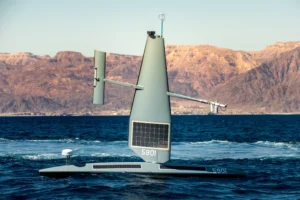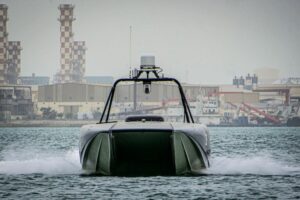The Navy recently issued a sources sought notice conducting market research for potentially using up to 10 “long dwell” Unmanned Surface Vessels (USVs), similar to the Saildrone vessels currently being tested in the Middle East.
The notice said the research is to support the Program Executive Office Unmanned & Small Combatants (PEO USC) in preliminary planning to acquire a contractor-owned and contractor-operated (COCO) USV of this type to support maritime domain awareness (MDA) wide area search mission outside the continental United States (OCONUS).

The Navy said this notice is being issued to identify contractors with the requisite expertise and capabilities that could be interested in responding to a follow-up Request for Proposals on these long dwell USVs.
Specifically, the notice says the craft hull should comply with at least ABS light warship codes in support of multi-domain operations, be capable of remaining on station in an area for over 120 days without in-person intervention by maintainers or operators, engine power to travel at upwards of nine knots to various OCONUS locations based on the needs of a fleet commander and include the ability to stay on station without using environmental aids like wind or underwater currents.
The Navy is also looking for the USV to include “continuous acoustic, radar, and visual sensors that are hard mounted to the platform,” power should be sufficient to support over 1,500W continuous loads for additional payloads, radar should be able to detect targets at at least 18 nautical miles and underwater acoustic sensors should have detection abilities over 16 nautical miles and over 5,000 feet deep.
The service wants sensor data on these long dwell USVs to be processed onboard the vehicle with automatic target recognition or artificial intelligence tools, encrypted, then sent to a ground station or government-owned common operating picture.
Notably, the notice said the craft should not contain any technology subject to International Traffic in Arms Regulations (ITAR).
Responses to this notice are directed to describe various potential production and contracting intentions as well as an approximate price to operate 10 vessels over 90 days.
Saildrone vessels have been used in several U.S. 5th Fleet unmanned systems and artificial intelligence exercises in the Middle East region, particularly with Task Force 59 (TF 59). The Navy previously boasted the Sailodrine vessels do not hold any classified information to minimize the risk of them being captured or stolen.
TF 59 is the fleet’s unit to help speed up integration of unmanned technologies via unilateral and multilateral international events and experiments, particularly using dual-use commercial technologies.
In October, Commander of 5th Fleet Vice Adm. Brad Cooper told reporters there is no intrinsic value or classified information kept on the Saildrone vessels being used, because any classified information is relayed elsewhere (Defense Daily, Oct. 17, 2022).

Cooper said the Navy was likely to stick to that pattern of having Saildrone-type USVs retaining little or no information they gather and just relay it elsewhere to limit the value of stealing them.
That came in the wake of Iranian attempts to capture several Saildrone USVs in August and September 2022 (Defense Daily, Aug. 30, 2022).
Cooper said the Navy puts measures in place with the USVs it is testing there to store data on a cloud, “so really, these platforms simply serve as a service and as a passage of information, which we’re then able to take into our headquarters.”
Last November, the Navy said the Saildrone Explorer USVs it has been using at sea have operated for up to 220 consecutive days without maintenance or refueling (Defense Daily, Nov. 23, 2022).
The Navy’s interest in these types of USVs is only increasing as both the technology advances and the U.S. military plans to create an international network of 100 USVs operating in the 5th Fleet area of operations with U.S. regional partners.
USVs that participated in 5th Fleet experiments thus far include the a Saildrone Explorer, Elbit Systems, Seagull,
L3Harris Technologies’ [LHX] Arabian Fox MAST-13, Marine Advanced Robotics’ Wave Adaptive Modular Vessel (WAM-V), MARTAC’s T-38 Devil Ray, Ocean Aero’s TRITON autonomous underwater and surface vehicle, Open Ocean Robotics’ Data Xplorer solar-powered USV, and SeaTrac’s SP-48 multi-purpose solar-powered ASV.
Last summer, Austal USA and Saildrone announced a partnership for the former’s Mobile, Ala., aluminum hull shipyard to become the exclusive builder of the Saildrone Surveyor USVs. These first Surveyors were planned to start building in October 2022 (Defense Daily, Aug. 30, 2022).